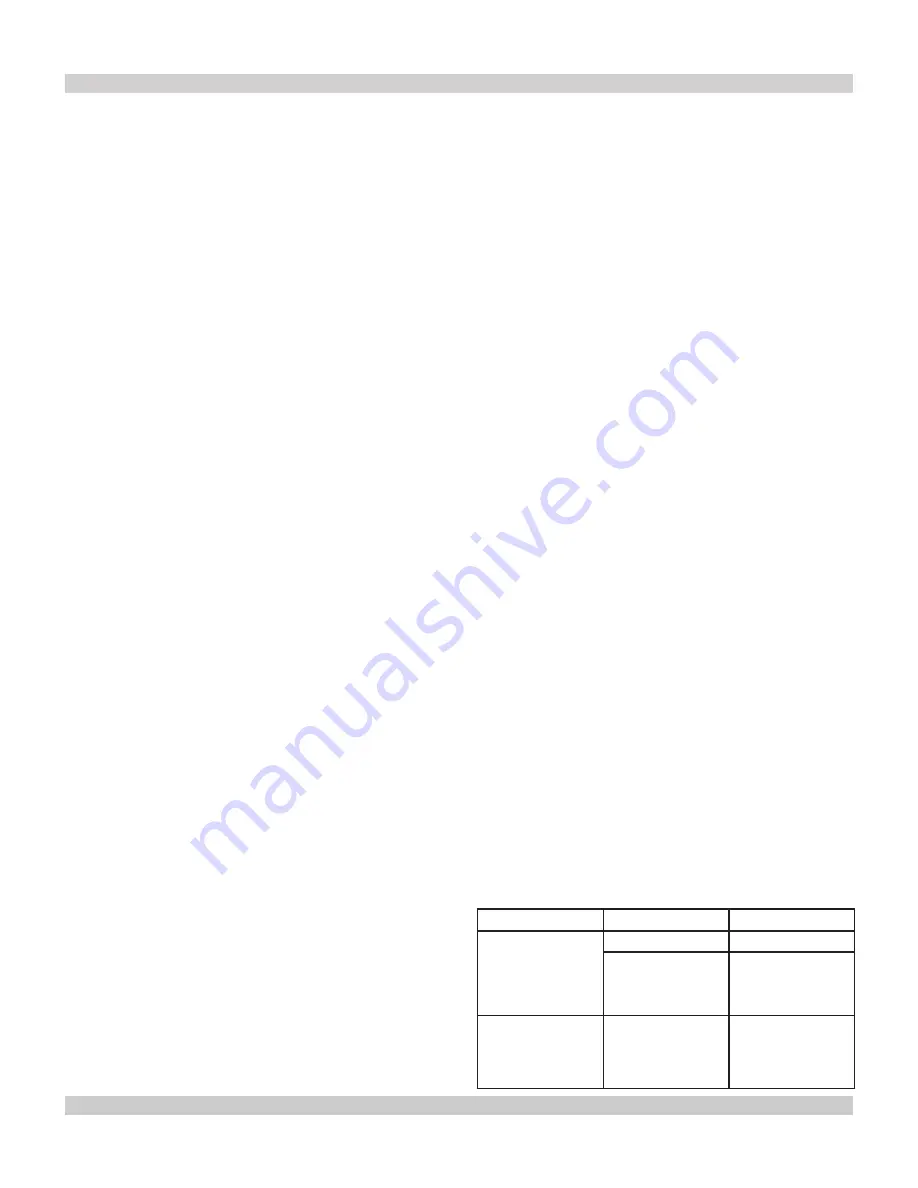
16
6 - COMBUSTION AIR AND VENT PIPING- CATEGORY I (CHIMNEY VENT)
6.4
Modulating Fan
• Unit is equipped with an advanced combustion air, vent
fl
ow control system, with modulating fan and pressure
sensor.
• Unit automatically adapts its operation to
fl
ue type
and length, without requiring adjustments during
installation or use of baf
fl
es in combustion circuit.
• Unit consistantly and automatically regulates
combustion air and vent
fl
ow according to change in
thermal load. Combustion and heat exchange occur in
optimum conditions. Unit’s thermal ef
fi
ciency remains
high throughout its power range.
6.5
Venting Materials
• See Table 3
6.2 Minimum Vent Pipe Clearance
• Use Type B vent pipe through crawl space. Where vent
pipe passes through combustible wall or partition, use
ventilated metal thimble. Thimble should be 4 inches
larger in diameter than vent pipe.
• Boiler installed with single wall vent, must have 6”
clearance between its surface and any combustible
material. New Type B gas vent or
fl
exible liner must be
installed in accordance with instructions furnished with
vent. Maintain clearances as speci
fi
ed for vent pipe.
• Verify vent pipe is
fi
re-stopped where it goes through
fl
oor or ceiling. It should have approved vent cap with
clearances from roof. If clearances are less than shown,
have vent checked by local authorities. Figure 13, Page
20.
• Vent connectors serving appliances vented by natural
draft shall not be connected into any portion of
mechanical draft systems operating under positive
pressure.
6.3 Removing Existing Boiler From Common
Venting System
When an existing boiler is removed from a common
venting system, common venting system is likely to be
too large for proper venting of the appliances remaining
connected to it.
1.
At the time of removal of an existing boiler, the
following steps shall be followed with each appliance
remaining connected to the common venting system
placed in operation, while the other appliance
remaining connected to the common venting system
are not in operation.
2.
Seal any unused openings in the common venting
system.
3.
Visually inspect the venting system for proper size and
horizontal pitch and determine there is no blockage or
restriction, leakage, corrosion and other de
fi
ciencies
which could cause an unsafe condition.
4.
Insofar as is practical, close all building doors and
windows and all doors between the space in which the
appliances remaining connected to the common venting
system are located and other spaces of the building.
Turn on clothes dryers and any appliance not connected
to the common venting system. Turn on any exhaust
fans, such as range hoods and bathroom exhausts, so
they will operate at maximum speed. Do not operate a
summer exhaust fan. Close
fi
replace dampers.
5.
Place in operation the appliance being inspected. Follow
the lighting instructions. Adjust thermostat so appliance
will operate continuously.
6.
Test for spillage at the draft hood relief opening after
5 minutes of main burner operation. Use
fl
ame of a
match or candle, or smoke from a cigarette, cigar, or
pipe.
7.
After it has been determined that each appliance
remaining connected to the common venting system
properly vents when tested as outlined above, return
doors, windows, exhaust fans,
fi
replace dampers and
any other gas-burning appliance to their previous
conditions of use.
8.
Any improper operation of the common venting system
should be corrected so the installation conforms with
the National Fuel gas Code, ANSI Z223.1/NFPA 54,
and/or the Natural Gas and Propane Installation Code,
CAN/CSA B149.1. When re-sizing any portion of the
common venting system, the common venting system
should be re-sized to approach the minimum size
determined using the appropriate tables in Chapter 13
of the National Fuel Gas Code, ANSI Z223.1/NFPA 54,
and/or the Natural Gas and Propane Installation Code,
CAN/CSA B149.1.
9.
It is recommended that existing gas vents be checked
to be sure they meet local codes.
Item
Material
Standards
Vent Pipe & Fittings
Type B Vent
UL 441, ULC S605
Masonry Chimney
- must conform to
proper sizing and
materials
National Fuel
Gas Code, ANSI
Z223.1/NFPA 54
Combustion Air
Stainelss Steel,
PVC, CPVC, PP,
Aluminum
ANSI/ASTM
D2564, ANSI/
ASTM F493, UL
1738/ULC636-08
Table 3 - Combustion Air and Vent Pipe Fittings
Category I (Chimney Vent)
Содержание CHB-100
Страница 6: ...Figure 2 Component Listing 6 3 GENERAL VIEW AND MAIN COMPONENTS ...
Страница 33: ...33 12 RATINGS AND CAPACITIES ...
Страница 38: ...KEY Part Number Description Qty A01 FE3980B830 CASING CTR 1 38 REPAIR PARTS LIST CHB 100 ...
Страница 40: ...40 REPAIR PARTS LIST CHB 100 ...
Страница 42: ...42 REPAIR PARTS LIST CHB 100 ...
Страница 44: ...KEY Part Number Description Qty A01 FE3980B830 CASING CTR 1 44 REPAIR PARTS LIST CHB 130 ...
Страница 46: ...46 REPAIR PARTS LIST CHB 130 ...
Страница 48: ...48 REPAIR PARTS LIST CHB 130 ...
Страница 50: ...NOTES 50 ...
Страница 51: ...NOTES 51 ...
Страница 52: ...ECR International Inc 2201 Dwyer Avenue Utica NY 13501 web site www ecrinternational com ...
















































